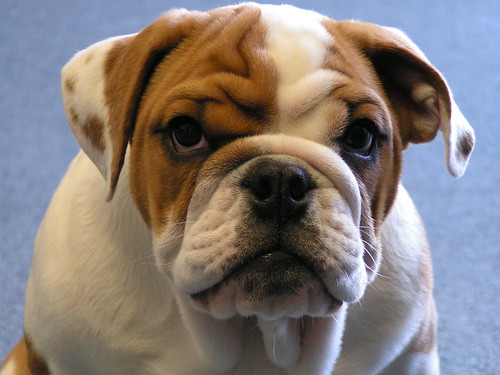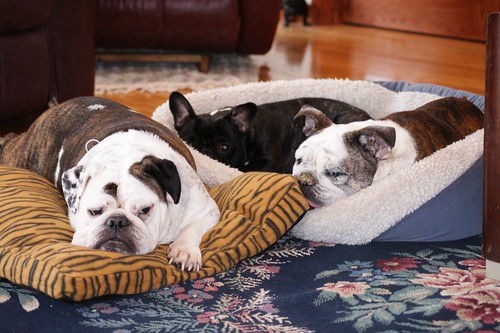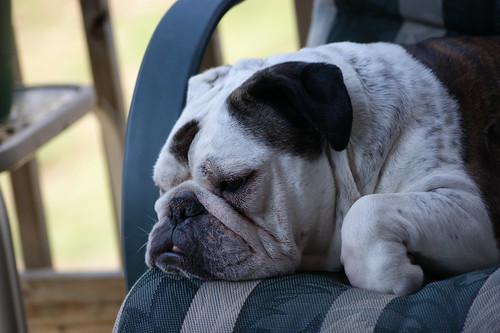A Bulldog, colloquially known as the British Bulldog, or English Bulldog, is a type of dog which traces its ancestry to England. It should not be confused with other varieties such as the American Bulldog or the French Bulldog, which has a similar appearance.
The bulldog is a stocky breed with characteristically broad shoulders and a matching wide head. There are generally thick folds of skin on a bulldog's brow, followed by round, dark, far apart eyes, a short muzzle, drooping lips, and the famous underbite.
Bulldogs come in a variety of colors and ideally have a smooth, short coat. The colors, in order of desirability, are brindle (especially red brindle), red (similar to a chestnut horse), white, and fawn (often with white markings on any color, or piebald). The prime disqualifier for the breed in the show ring is a pale or liver-colored nose (although black-coated bulldogs are not preferred, and many judges will dismiss a bulldog lacking an underbite).
In the US, the size of a typical mature male is about 50 pounds and that for mature females is about 40 pounds. In the [United Kingdom], the breed standard is 55 pounds for a male and 50 pounds for a female, though it is not uncommon for males to be 70 pounds.
While some canine breeds require their tails to be cut or "cropped" soon after birth, bulldogs are one of very few breeds whose tail is naturally short and curled. A longer or "gay" tail is a serious fault in a show bulldog.
Bulldogs come in a variety of colors and ideally have a smooth, short coat. The colors, in order of desirability, are brindle (especially red brindle), red (similar to a chestnut horse), white, and fawn (often with white markings on any color, or piebald). The prime disqualifier for the breed in the show ring is a pale or liver-colored nose (although black-coated bulldogs are not preferred, and many judges will dismiss a bulldog lacking an underbite).
In the US, the size of a typical mature male is about 50 pounds and that for mature females is about 40 pounds. In the [United Kingdom], the breed standard is 55 pounds for a male and 50 pounds for a female, though it is not uncommon for males to be 70 pounds.
While some canine breeds require their tails to be cut or "cropped" soon after birth, bulldogs are one of very few breeds whose tail is naturally short and curled. A longer or "gay" tail is a serious fault in a show bulldog.
Despite their famous "sourmug" expression, bulldogs are generally docile although can prove to be very fast movers over a short distance. They are friendly and gregarious but occasionally willful. The phrase "stubborn as a bulldog" is loosely rooted in fact.
Breeders have worked to breed aggression out of the breed, and as such the dog is known to be of generally good temperament. Bulldogs can be so attached to home and family that they will not venture out of the yard without a human companion. Due to their friendly nature bulldogs are known for getting along well with children, other dogs and pets.
A bulldog is suitable for houses as well as apartments due to their size. Most bulldogs are content to walk at most half a mile and thus may suit a less-active person. They are not excitable, seldom bark, and are easily trainable as compared with many other breeds.
Breeders have worked to breed aggression out of the breed, and as such the dog is known to be of generally good temperament. Bulldogs can be so attached to home and family that they will not venture out of the yard without a human companion. Due to their friendly nature bulldogs are known for getting along well with children, other dogs and pets.
A bulldog is suitable for houses as well as apartments due to their size. Most bulldogs are content to walk at most half a mile and thus may suit a less-active person. They are not excitable, seldom bark, and are easily trainable as compared with many other breeds.
The bulldog's unique traits sometimes contribute to specific health issues. Breathing problems can be prevalent in the breed due to the shape and the shortness of its muzzle. Most noticeably, bulldogs are known to snore loudly.
Some individuals of this breed are prone to interdigital cysts, which are cysts that form between the toes. These cause the dog some discomfort, but are treatable either by vet or an experienced owner.
Other problems can include cherry eye, a protrusion of the inner eyelid (which can be corrected by a veterinarian), certain allergies, and hip issues in older bulldogs. However, bulldogs are bred to be bowlegged in the hind-legs and thus do not usually develop hip dysplasia.
Puppies are frequently delivered by Caesarean section because their characteristically large heads can become lodged in the mother's birth canal during natural birth. However, it is not entirely uncommon for a bulldog to whelp naturally and successfully.
The folds or "rope" on a Bulldog's face should be cleaned daily to avoid unwanted infections caused by moisture accumulation. Also, some bulldogs' naturally curling tails can be so tight to the body as to require regular cleaning and a bit of ointment.
Like all dogs, bulldogs require daily exercise. If not properly exercised it is possible for a bulldog to become overweight, which could lead to heart and lung problems, as well as joint issues.
Bulldogs are extremely sensitive to heat. Extra caution should be practiced in warmer climates and during summer months. Bulldogs must be given plenty of shade and water, and must be kept out of standing heat.
In January 2009, after the BBC documentary Pedigree Dogs Exposed, the The Kennel Club introduced revised breed standards for the British Bulldog, along with 209 other breeds, to address health concerns. Opposed by the British Bulldog Breed Council, it was speculated by the press that the changes would lead to a smaller head, less skin folds, a longer muzzle, and a taller thinner posture, in order to combat perceived problems with respiration and with breeding due to head size and posture.
Some individuals of this breed are prone to interdigital cysts, which are cysts that form between the toes. These cause the dog some discomfort, but are treatable either by vet or an experienced owner.
Other problems can include cherry eye, a protrusion of the inner eyelid (which can be corrected by a veterinarian), certain allergies, and hip issues in older bulldogs. However, bulldogs are bred to be bowlegged in the hind-legs and thus do not usually develop hip dysplasia.
Puppies are frequently delivered by Caesarean section because their characteristically large heads can become lodged in the mother's birth canal during natural birth. However, it is not entirely uncommon for a bulldog to whelp naturally and successfully.
The folds or "rope" on a Bulldog's face should be cleaned daily to avoid unwanted infections caused by moisture accumulation. Also, some bulldogs' naturally curling tails can be so tight to the body as to require regular cleaning and a bit of ointment.
Like all dogs, bulldogs require daily exercise. If not properly exercised it is possible for a bulldog to become overweight, which could lead to heart and lung problems, as well as joint issues.
Bulldogs are extremely sensitive to heat. Extra caution should be practiced in warmer climates and during summer months. Bulldogs must be given plenty of shade and water, and must be kept out of standing heat.
In January 2009, after the BBC documentary Pedigree Dogs Exposed, the The Kennel Club introduced revised breed standards for the British Bulldog, along with 209 other breeds, to address health concerns. Opposed by the British Bulldog Breed Council, it was speculated by the press that the changes would lead to a smaller head, less skin folds, a longer muzzle, and a taller thinner posture, in order to combat perceived problems with respiration and with breeding due to head size and posture.







No comments:
Post a Comment